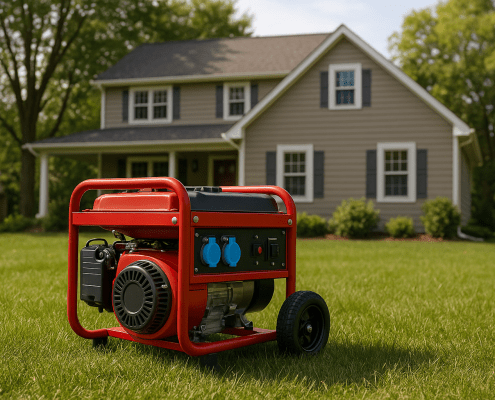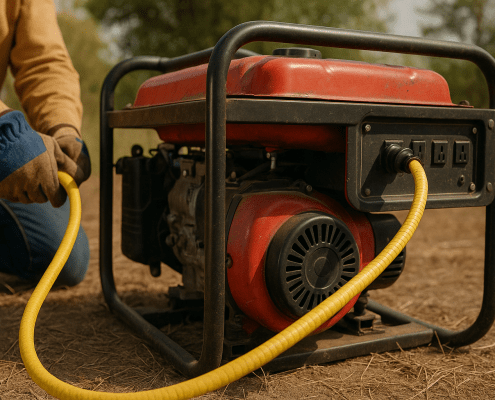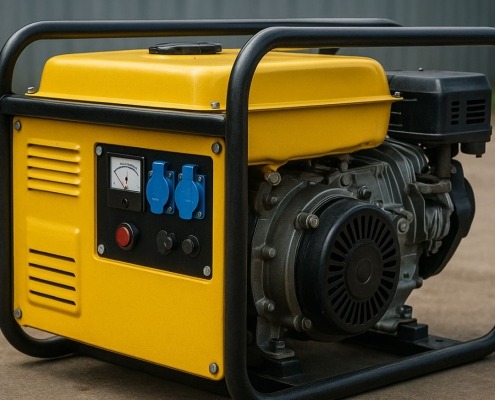A Maintenance Guide to Keeping Your Generator Running Strong
Steven E / Wednesday April 30, 2025
A generator is one of those machines you don’t think about much until the power goes out and it becomes the MVP of your home, job site, or camping trip. But here’s the catch: if you don’t take care of your generator, it might not be there for you when you need it most.
Like any engine, a generator needs regular maintenance to perform reliably. The good news? It’s not hard. With a few simple steps and a little consistency, you can extend your generator’s life, avoid costly repairs, and ensure it starts up every time, no stress, no drama.
We’ll walk you through the essential generator maintenance tips that every DIYer and homeowner should know. Whether you’ve got a portable gas generator or a standby backup unit, these practical steps will keep your power source ready to go.
If you need any replacement parts for your appliance, you can enter your model number at AppliancePartsPros.com to order them. Most orders arrive in just two business days, and we have thousands of free guides to show you how to install your new parts.
The information in this article may not apply to your specific appliance model. We recommend consulting your manufacturer’s documentation or contact us with any questions.
Why Generator Maintenance Matters
Let’s be honest, generators don’t get used often. That’s kind of the point. But because they sit idle for long periods, they’re actually more prone to issues like fuel degradation, corrosion, and sticky parts.
Routine maintenance helps:
- Ensure quick, reliable starts
- Prevent engine damage
- Extend the lifespan of your generator
- Keep fuel and electrical systems clean
It’s a small task that pays off big over time.
Tip #1: Run It Regularly
One of the best things you can do for your generator is to run it occasionally, even when you don’t need it.
Generators that sit too long without use can lose residual magnetism, develop stale fuel, or have batteries that slowly die (in the case of electric start models). To keep everything moving smoothly:
Run your generator for 15–20 minutes once a month with a light load (like a work light or fan). This keeps parts lubricated, the battery charged, and fuel flowing through the system.
Tip #2: Change the Oil Regularly
Just like your car, your generator engine needs clean oil to run well.
When to change the oil:
- After the first 20–30 hours of use (break-in period)
- Every 50–100 hours after that, or at least once per season
- Immediately after extended use (like during a power outage)
How to do it:
- Run the engine for a few minutes to warm the oil (helps it drain faster).
- Shut it off and unplug the spark plug.
- Place a pan under the oil drain plug and remove it.
- Let the oil drain completely.
- Replace the drain plug and refill with the recommended oil type (usually SAE 10W-30).
Always check your owner’s manual for the exact type and amount.
Tip #3: Use Fresh Fuel, and a Stabilizer
Fuel left in the tank too long can break down, gum up the carburetor, and cause starting issues.
Best practice:
- Only fill your tank with as much fuel as you’ll use in 1–2 months.
- Add a fuel stabilizer (like STA-BIL) if your generator will sit longer than 30 days.
- Store extra fuel in an approved gas can, and label the date it was filled.
If your generator hasn’t been run in 3+ months and the fuel smells sour, it’s time to drain and replace it.
Tip #4: Keep the Air Filter Clean
A clogged air filter can make your generator run rough, use more fuel, or even shut down unexpectedly.
How to check:
- Remove the air filter cover.
- If the filter looks dirty, dusty, or oily, it needs cleaning or replacing.
Foam filters can be washed with mild soap and water, dried completely, then re-oiled before reinstallation.
Paper filters should be replaced when dirty.
Check it every 25 hours of use or once a season.
Tip #5: Inspect and Replace the Spark Plug
The spark plug is essential for starting and running your generator smoothly.
Signs your spark plug needs attention:
- Hard starting
- Misfiring or rough running
- Black or oily residue on the tip
Maintenance steps:
- Remove the spark plug with a socket wrench.
- Inspect the tip for wear or build-up.
- Clean with a wire brush if it’s mildly dirty, or replace it if it looks damaged or fouled.
- Gap the new plug using a feeler gauge (check your manual for the correct gap).
- Reinstall and tighten gently, don’t overdo it.
Replace the spark plug once a year or every 100 hours for best results.
Tip #6: Clean the Carburetor (If Needed)
If your generator runs rough, surges, or won’t start after sitting for a while, the carburetor might be gummed up with old fuel residue.
DIY carb cleaning basics:
- Remove the air filter and fuel line.
- Take off the carburetor bowl and clean out any debris.
- Spray with carburetor cleaner and gently scrub internal parts.
- Reassemble and test.
You can also prevent carb problems by draining the fuel or using a shutoff valve to run the carb dry after each use.
Tip #7: Check the Battery (for Electric Start Models)
If your generator has a push-button or key start, it’s powered by a small rechargeable battery.
To maintain it:
- Check and charge the battery monthly.
- Use a trickle charger or battery maintainer to keep it topped off during long storage.
- Replace the battery every 2–3 years, or sooner if it won’t hold a charge.
Dead batteries are one of the top reasons electric-start generators fail during an outage, so don’t overlook this step.
Tip #8: Inspect Cords and Connections
A working engine won’t help much if your outlets or cords are damaged.
What to look for:
- Cracked or frayed extension cords
- Loose or corroded outlet sockets
- Signs of overheating or melted plastic
Always use heavy-duty outdoor-rated cords that match the generator’s wattage rating, and never overload a circuit.
Check all wiring and plugs at least once per season, or after heavy use.
Tip #9: Keep It Covered, but Not Airtight
Generators should be stored in a dry, well-ventilated space, away from rain, dust, and rodents. But you don’t want to wrap them up completely, moisture buildup can cause corrosion.
Storage tips:
- Use a generator cover or breathable tarp.
- Keep it off bare concrete (which can draw moisture).
- Store it with the gas tank empty or fuel stabilizer added.
- Disconnect the battery (if equipped) during long-term storage.
For portable models, storing in a shed or garage is ideal. Just make sure there’s room for airflow when you need to run it.
Tip #10: Follow a Seasonal Checklist
To make maintenance even easier, follow a seasonal schedule to stay on top of key tasks. Here’s a basic breakdown:
Every Use:
- Check oil level
- Inspect for fuel leaks
- Look for loose bolts or parts
- Ensure nothing is blocking the vents
Monthly:
- Run for 15–20 minutes with a light load
- Charge the battery (if electric start)
- Inspect cords and plugs
Seasonally (or every 50–100 hours):
- Change the oil and oil filter
- Clean or replace air filter
- Check spark plug
- Drain or treat fuel
- Inspect wheels, frame, and grounding
Stick to this routine, and your generator will stay in great shape all year round.
Bonus Tip: Keep a Logbook
It might sound overly organized, but keeping a maintenance log helps you track what you’ve done and when. Just jot down the date, what was done (oil change, filter clean, spark plug), and how many hours were on the generator at the time.
This is super helpful if something goes wrong or you plan to sell the unit later.
Additional reading
Thanks for reading! If you need replacement parts for any of your appliances, check out AppliancePartsPros.com, where you can enter your model number to find exactly what you’re looking for. Most orders arrive in two business days, and we have thousands of free resources to show you how to install your new parts.
You can also reach our award-winning customer service team at 1-877-477-7278, chat with a pro on our website and watch thousands of free video tutorials on our YouTube channel.
With nearly a decade of experience in providing top-notch customer service regarding appliance parts and repair, Steven enjoys sharing practical advice, troubleshooting tips, and interesting information to help readers stay informed.





